
Mount Vernon is a neighborhood of Baltimore, Maryland, located immediately north of the city's downtown. It is named for George Washington's Mount Vernon estate in Virginia, as the site of the city's Washington Monument.

The Alex. Brown & Sons building is a historic structure located at 135 East Baltimore Street in Baltimore, Maryland. During the 20th century it served as the corporate headquarters for the banking firm Alex. Brown & Sons, the oldest in the United States when it was purchased by Bankers Trust in 1997. The two-story building, completed in 1901 and designed by the partnership of J. Harleston Parker and Douglas H. Thomas. Jr., survived the 1904 Baltimore fire. The building was modified on the Calvert Street side and in the interior by the firm Beecher, Friz, and Gregg in 1905.

The First Unitarian Church is a historic church and congregation at 12 West Franklin Street in Mount Vernon, Baltimore, Maryland. Dedicated in 1818, it was the first building erected for Unitarians in the United States. The church is a domed cube with a stucco exterior. The church, originally called the "First Independent Church of Baltimore", is the oldest building continuously used by a Unitarian congregation. The name was changed in 1935 to "The First Unitarian Church of Baltimore " following the merger with the former Second Universalist Church at East Lanvale Street and Guilford Avenue in midtown Baltimore. The American Unitarian Association and the Universalist Church of America (established 1866) representing the two strains of Unitarian Universalism beliefs and philosophies merged as a national denomination named the Unitarian Universalist Association in May 1961.

The College of Medicine of Maryland, or also known since 1959 as Davidge Hall, is a historic domed structure in Baltimore, Maryland. It has been in continuous use for medical education since 1813, the oldest such structure in the United States. A wide pediment stands in front of a low, domed drum structure, which housed the anatomical theater. A circular chemistry hall was housed on the lower level under the anatomical theater.

Seton Hill Historic District is a historic district in Baltimore, Maryland. It was listed on the National Register of Historic Places in 1975.
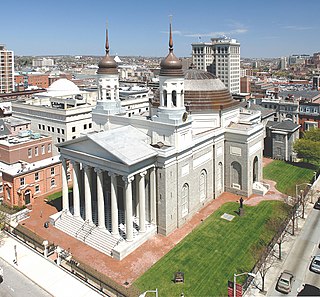
The Cathedral Hill Historic District is an area in Baltimore, Maryland. It lies in the northern part of Downtown just south of Mount Vernon. Roughly bounded by Saratoga Street, Park Avenue, Hamilton Street, and St. Paul Street, these 10 or so blocks contain some of the most significant buildings in Baltimore. The area takes its name from the Basilica of the Assumption which sits in the heart of the district. Despite the number of large religious structures in the area, the district's buildings are primarily commercial in character, with a broad collection of significant commercial structures ranging in date from 1790 to 1940.
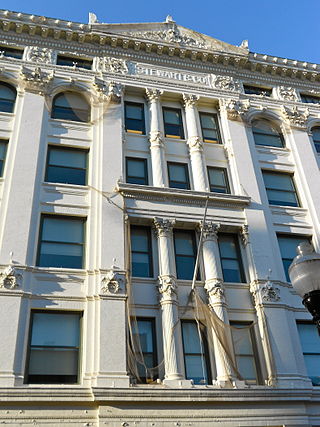
Stewart's Department Store, also known as the Posner Building, is a historic department store building located on Howard Street at Baltimore, Maryland, United States. Catholic Relief Services is currently headquartered there.
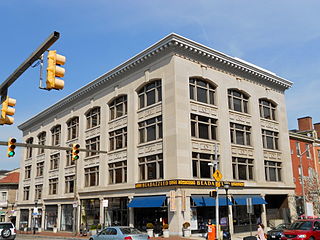
Benson Building, also known as the IPC Building, is a historic retail and office located at Baltimore, Maryland, United States. It is on the corner of East Franklin and North Charles Streets. The main side is on Charles Street and has seven bays with store windows and entrances on the first floor, and office windows on the upper floors. The recessed storefronts feature bronzed aluminum infill panels above and below the glass panes. It was constructed in 1911 and the principal original occupant was C.J. Benson and Company, a local interior decorating and furniture establishment.

Building at 419 West Baltimore Street, also known as Harry Guss Inc., is a historic retail and wholesale building located at Baltimore, Maryland, United States. It is a three-story gable-roofed Flemish bond brick Federal-style building built about 1840. Around 1875, a four-bay cast-iron storefront was added at street level. It was used in the garment manufacturing and sales industries.

Building at 423 West Baltimore Street is a historic retail and wholesale building located at Baltimore, Maryland, United States. It is a five-story loft structure of the Queen Anne style. It achieved its present configuration in 1893, as the result of extensive alteration of an existing three-story brick warehouse. The storefront retains its important cast-iron elements, and the upper floors are essentially unchanged.

George Knipp & Brother Building is a historic retail building located at Baltimore, Maryland, United States. It is a five-story brick commercial structure with a four-bay cast-iron façade, constructed about 1875. It features large window openings flanked by Corinthian columns. It was originally the location of John Knipps’ furniture business and his brother George Knipp's enterprise in gas fixtures and plumbing supplies. It was later occupied by a furniture and carpet firm and later a J.G. McCrory Co. store.

L. Frank & Son Building is a historic retail building located at Baltimore, Maryland, United States. It is a four-story brick commercial building with a cast-iron façade, built about 1875. It was constructed for Samuel Stein & Bros., and occupied by a dealer in iron ranges and furnaces, and later a series of shoe and clothing manufacturers.

Johnston Building was a historic wholesale building located at Baltimore, Maryland, United States designed by Jackson C. Gott. It is a five-story loft building constructed in 1880. The cast iron façade reflected the influence of the Queen Anne style. It housed wholesale companies dealing in tobacco, hats, shoes, clothing, and home and office furnishings, including Samuel Hecht, Jr. & Sons. It was demolished in 2002.

Old Town Savings Bank, also known as Cala Brothers, is a historic loft building located at Baltimore, Maryland, United States. It is a three-story loft structure designed by architect Frank E. Davis (1839-1921) and constructed in 1871. Both the street façades are cast iron, four bays wide on Gay Street and eight bays wide on Exeter Street. It is a Full Cast Iron Front building. It operated as a bank until about 1940, then housed a wholesale distributor of tobacco and confectionery.

Montgomery Ward Warehouse and Retail Store is a historic warehouse and retail building in Baltimore, Maryland, United States. It is an eight-story concrete structure and is roughly shaped like a squared-off number "4". The front features a penthouse tower at the main entrance bay with a balcony and capped by a flagpole. The building houses over 1,200,000 square feet (110,000 m2) of floor space flooded by light from approximately 1,000 large multi-paned, steel frame windows. It was built about 1925 as a mail order and retail warehouse for Montgomery Ward on an 11 acres (4.5 ha) site adjacent to the Baltimore and Ohio Railroad tracks. The complex was one of nine large warehouses built by the company in the United States.

Eastern Female High School, also known as Public School No. 116, is a historic female high school located on the southeast corner of the 200 block of North Aisquith Street and Orleans Street, in the old Jonestown / Old Town neighborhoods, east of Downtown Baltimore and now adjacent to the recently redeveloped Pleasant View Gardens housing project / neighborhood of Baltimore, Maryland, United States. It was built in 1869-1870 and is typical of the Italian Villa mode of late 19th-century architecture. It was dedicated in a large ceremony with speeches later published in a printed pamphlet and attending crowds in early 1870. Old Eastern High is a two-story brick structure that features a square plan, three corner towers, and elaborate bracketing cornices, with a similar wood decorated porch/portico over front entrance on its west side facing Aisquith Street.
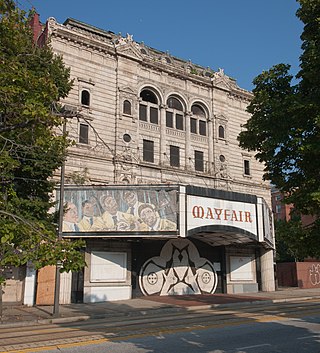
Market Center is a national historic district in Baltimore, Maryland, United States. It is an approximately 24-block area in downtown Baltimore that includes buildings associated with the development of the area as Baltimore's historic retail district. The area evolved from an early 19th-century neighborhood of urban rowhouses to a premiere shopping district featuring large department stores, grand theaters, and major chain stores. The diverse size, style, scale, and types of structures within the district reflect its residential origins and evolution as a downtown retail center.
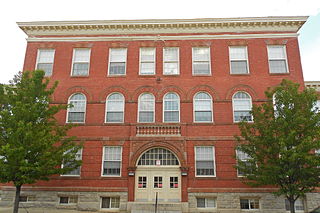
Franklin Square Historic District is a national historic district in Baltimore, Maryland, United States. It is a 19th-century rowhouse neighborhood developed along a strict grid street pattern. A one square block, two and a half acre public park, Franklin Square, is a focal point for the area and the most elaborate rowhousing surrounds the square. The district contains approximately 1,300 buildings of which approximately 1,250 contribute to the significance of the historic district.

Zion Lutheran Church, also known as the Zion Church of the City of Baltimore, is a historic Evangelical Lutheran church located in downtown Baltimore, Maryland, United States, founded 1755.
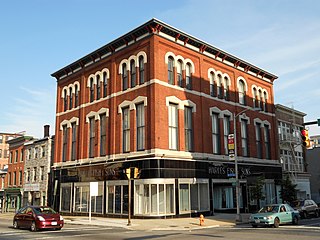
The Old Baltimore College of Dental Surgery is an historic commercial building on North Eutaw Street in Baltimore, Maryland. The three-story brick building was built in 1881, and served as the fifth location of the Baltimore College of Dental Surgery, the nation's first dental school. It is one of two surviving 19th century addresses of the school, which was founded in 1839. The building's first floor, which was always used for commercial and retail purposes, has seen some remodeling, but the upper floors, used by the school, have retained a great deal of historic integrity.

























